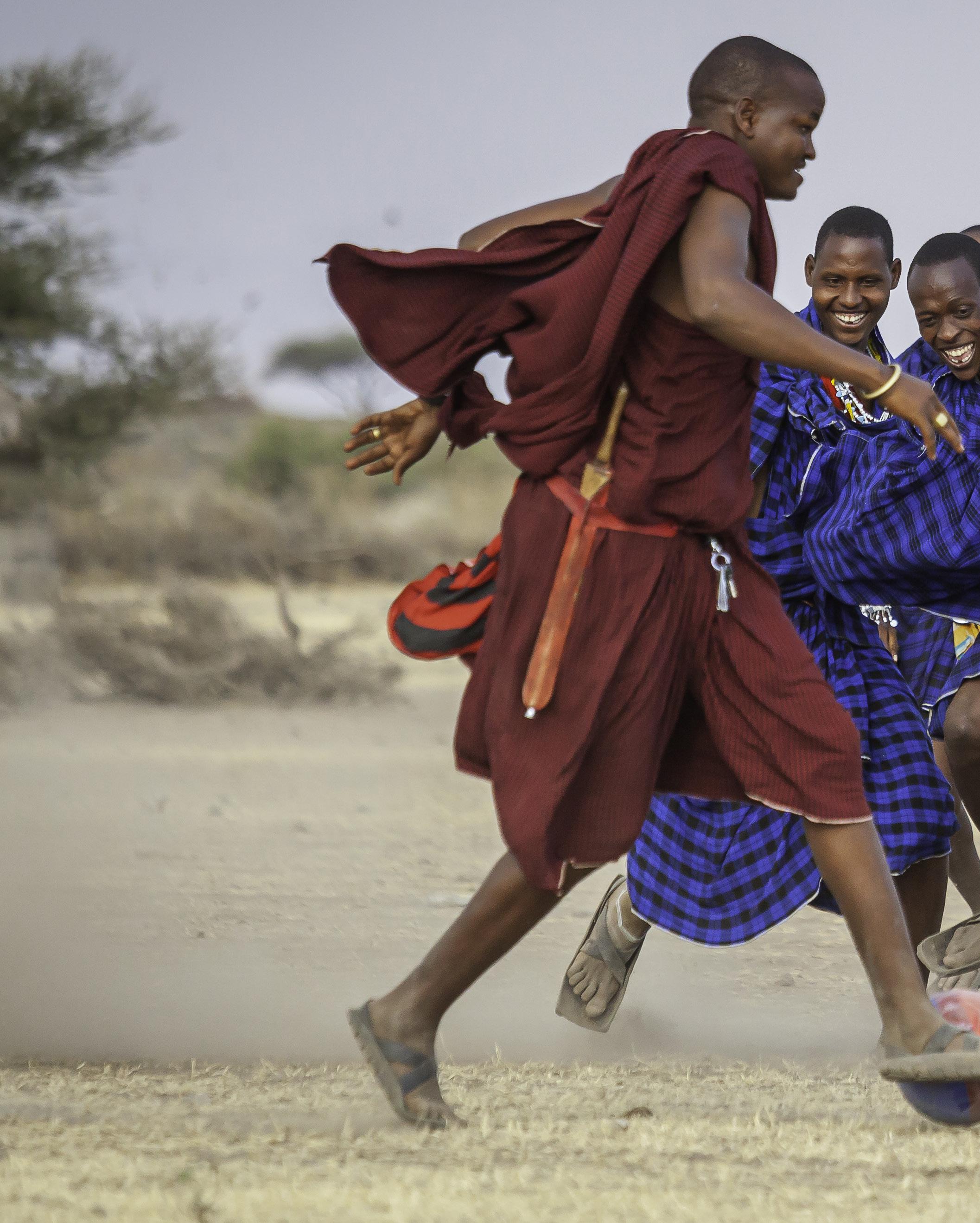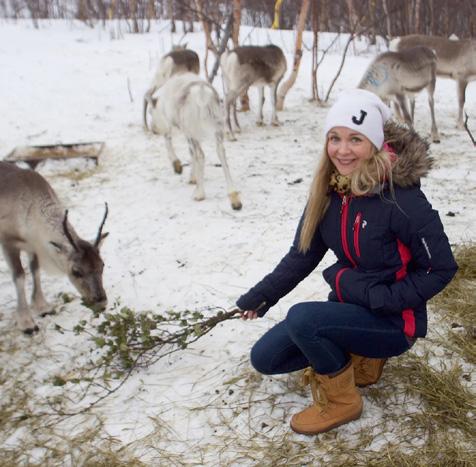
7 minute read
SUSTAINABILITY STORIES
PIONEERING AUTHENTIC CULTURAL IMMERSION
Offering sustainable and responsible travel experiences with indigenous cultures, we dive into Visit Natives with Founder, Anniina Sandberg
Writer: Phoebe Harper
Photo: Selim Tanfouns

Cultural appropriation is a problem in tourism, and that’s a real concern because so many elements of indigenous cultures – whether a costume or a custom – can be taken away from that community and exploited.”
When Anniina Sandberg left Finland to live with the Maasai tribe in Tanzania as part of her African Studies course, the experience opened a window into authentic indigenous culture that would have a lasting impact.
“Having such an immersive cultural experience was one of the best things that I have ever done, and it made me start questioning how I could combine my passions for both sustainable tourism and indigenous cultures,” she recalls.
Keen to share an opportunity for such encounters with other travellers – especially those who may not be able to afford several months away for volunteer work – Sandberg went on to found Visit Natives in 2018 with its first trips launching the following year.
Specialising in off-the-beaten track stays with indigenous communities, the company currently offers adventures with Sami in Northern Norway, and the Maasai, Datoga and Hadzabe in Tanzania.
Anniina Sandberg
THE VISIT NATIVES DIFFERENCE
The model of tourism that Visit Natives promotes is founded on responsible ethics and sustainability. It is a far cry from the performative ‘pop-up’ villages and cultural demonstrations so frequently found in mass-tourism.
“Often, indigenous people are involved in village set ups or performances, they are not typically paid well, and the experience isn’t maintained by that community,” Sandberg observes. “When it is not controlled by them, we cannot call the experience responsible, sustainable, or even ethical.”
She goes on to cite how the image of a Maasai is so frequently used to market tourism experiences in Kenya or Tanzania, whilst questioning if that really brings any benefit to the community. Similarly, the traditional clothes of the Sami tribe are often worn by Finnish and Norwegian nationals to attract tourist numbers, with no respect for the apparel’s sacred status and total disregard for the various meanings attributed to each costume. Contrary to these trends, a Visit Natives experience allows often vulnerable indigenous communities – especially those in need of extra income in order to preserve a traditional lifestyle – complete autonomy. “Our priority when we talk about sustainable indigenous tourism, is that it must be managed and planned by that community. All our experiences are 100 percent run and designed by the indigenous community and the people within them - my role is purely to market and sell those products,” she expands.
With total freedom to control the product, all trip costs are determined by their respective host community. Complementing this, Visit Natives only works with communities who are receptive and open to tourism experiences. On the Arctic tundra and the savannahs of Tanzania, this can be rare. As such, these experiences should be respected for the unique opportunity they afford.

Photo: Sandra Zagolin “When tourism is done well and managed properly, it can really benefit indigenous communities...All of our experiences are 100 percent run and designed by the community and the people within them”

– Anniina Sandberg, Founder, Visit Natives
Photo: Selim Tanfouns Photo: Selim Tanfouns







Photo: Sandra Zagolin
Photo: Sandra Zagolin Photo: Sandra Zagolin
“We match with those communities and together we build business in a respectful way.” Indeed, respect is the bedrock of the Visit Natives experience.
“Our approach with indigenous communities is to be a humble guest who is there by invitation only, and that is how we build meaningful connections. Our guests often comment that they feel as if they are a new family member by the time they leave,” Sandberg enthuses.
FOUNDED ON FAIR TOURISM
Not only do such experiences foster a respect and freedom for indigenous communities whilst creating a means of revenue generation, but they are also entirely mutually beneficial in fulfilling the needs of the tourists on the other side of the experience.
“Competition is tough in Tanzania, since there are so many opportunities to visit a set up Maasai village. But typically, tourists come here for a few hours, and leave with the impression that the Maasai are asking for money, whilst the Maasai may feel taken advantage of,” she observes.
“I feel bad for both sides, since neither of their needs are met!”
Naturally, travellers want to feel they are in an environment where they are a welcome presence, as opposed to just an “open wallet”, as Sandberg calls it. “It has to work in a way where both sides are listened to, and respected.”
Whilst the Sami Reindeer Spring Migration is Visit Natives’ signature experience and best-selling product, Sandberg hints at new destinations and experiences with communities to come in the New Year.
“With both climate change and the aftermath of COVID-19, we are not telling people to travel more. Rather, they should be travelling less, but doing so in a more meaningful way where we all take time to think about where we want to put our money.”
Tell us your story and we’ll tell the world
Outlook Travel Magazine is a digital and print publication aimed at business executives and avid travellers, reaching an audience of more than 575,000 people. Working closely with tourism boards and associations around the globe, from cities to regions, from countries to continents, we take an in-depth look at where to visit, where to stay and what to do when you are there.
With original and exclusive content compiled by our experienced editorial team, complemented by an in-house design and production team ensuring delivery to the highest standards, we look to promote the latest trends, blogs, reviews and success stories from this fast-moving industry.

You can join the vast numbers of tourism sector players enjoying the exposure we provide across our digital platforms with a range of options, from advertising through to free-of-charge editorials, extensive social media saturation, enhanced B2B networking opportunities, and a readymade forum to attract new investment and increase exposure.
To get involved, please contact Outlook Publishing’s Managing Director, James Mitchell, who can provide further details on how to feature your company, for free, in one of our upcoming editions.
ST. ANTON
TRAVEL GUIDE
ST. ANTON
FREE Marketing Opportunity
ST ANTON ST ANTON

TRAVEL GUIDE ST. ANTON
Inside a breathtaking alpine resort aiming to become the global ski village
FEATURE: SUSTAINABILITY STORIES


Lifting the lid on indigenous cultures
TRAVEL GUIDE: WESTERN AUSTRALIA
Step into the dreamscape Known as the cradle of alpine skiing, St. Anton is the mountainous Austrian village transforming into a premium global ski resort
Writer: Ed Budds | Project Manager: Dave West Found within the Arlberg region of the mighty Austrian Alps, St. Anton caters for every possible variety of winter explorer. Whether craving an adrenaline-fuelled, actionpacked week of high-octane winter sports, or a hiking adventure through the stunning mountain range, St. Anton delivers on all fronts for every demographic of tourists.
Evoking visions of far more than just a cosy wintery ambience and the iconic location of the British film, Chalet Girl, St. Anton exists as a spiritual home of skiing, where pioneers such as the Stuben am Arlberg-born Hannes Schneider invented the Arlberg technique at the start of the 20th century. Providing the blueprints of modern alpine skiing, this technique revolutionised the sport, just as St. Anton has revolutionised the full-package ski resort.
Visitors are spoilt for choice when it comes to bars and restaurants in St. Anton. Whether seeking an afternoon of beer drinking or simply a relaxed, wine-fuelled afternoon admiring the scenery, this stylish and welcoming resort has it covered in full.
2 | Outlook Travel Issue 10 Outlook Travel Issue 10 | 3
From surf shoots to road-tripping across the Baltic states, we go behind the lens with commercial and editorial photographer, Lauryn Ishak
www.outlooktravelmag.com/work-with-us











